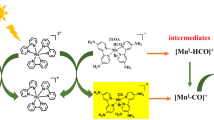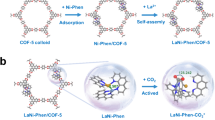Abstract
Five Au complexes are evaluated for the reduction reaction of CO2 via cyclic voltammetry and in a photocatalytic system. Electrochemically, the complexes were all evaluated for pre-association with CO2 prior to electrochemical reduction and for thermodynamic favorability for CO2 reduction in photocatalytic systems. The complexes were evaluated in photocatalytic reactions using an Ir-based photosensitizer and a sacrificial electron donor for the conversion of CO2 to CO. Au-complex counterion effects on the photocatalytic reaction were analyzed by varying weakly coordinating counterions with significant performance changes noted. At low Au-complex concentrations, a high TON value of 700 was observed.




Similar content being viewed by others
References
V.R. Jupally, A.C. Dharmaratne, D. Crasto, A.J. Huckaba, C. Kumara, P.R. Nimmala, N. Kothalawala, J.H. Delcamp, and A. Dass: Au137(SR)56 nanomolecules: composition, optical spectroscopy, electrochemistry and electrocatalytic reduction of CO2. Chem. Commun. 50, 9895 (2014).
D.R. Kauffman, D. Alfonso, C. Matranga, H. Qian, and R. Jin: Experimental and computational investigation of Au25 clusters and CO2: a unique interaction and enhanced electrocatalytic activity. J. Am. Chem. Soc. 134, 10237 (2012).
Y. Chen, C.W. Li, and M.W. Kanan: Aqueous CO2 reduction at very low overpotential on oxide-derived Au nanoparticles. J. Am. Chem. Soc. 134, 19969 (2012).
K. Sun, T. Cheng, L. Wu, Y. Hu, J. Zhou, A. Maclennan, Z. Jiang, Y. Gao, W.A. Goddard 3rd, and Z. Wang: Ultrahigh mass activity for carbon dioxide reduction enabled by gold-iron core-shell nanoparticles. J. Am. Chem. Soc. 139, 15608 (2017).
H. Kim, H.S. Park, Y.J. Hwang, and B.K. Min: Surface-morphology-dependent electrolyte effects on gold-catalyzed electrochemical CO2 reduction. J. Phys. Chem. C 121, 22637 (2017).
A.J. Huckaba, E.A. Sharpe, and J.H. Delcamp: Photocatalytic reduction of CO2 with Re-Pyridyl-NHCs. Inorg. Chem. 55, 682 (2016).
J.D. Cope, N.P. Liyanage, P.J. Kelley, J.A. Denny, E.J. Valente, C.E. Webster, J.H. Delcamp, and T.K. Hollis: Electrocatalytic reduction of CO2 with CCC-NHC pincer nickel complexes. Chem. Commun. 53, 9442 (2017).
S. Das, R.R. Rodrigues, R.W. Lamb, F. Qu, E. Reinheimer, C.M. Boudreaux, C.E. Webster, J.H. Delcamp, and E.T. Papish: Highly active ruthenium CNC pincer photocatalysts for visible-light-driven carbon dioxide reduction. Inorg. Chem. 58, 8012 (2019).
R.R. Rodrigues, C.M. Boudreaux, E.T. Papish, and J.H. Delcamp: Photocatalytic reduction of CO2 to CO and formate: do reaction conditions or ruthenium catalysts control product selectivity?ACS Appl. Energy Mater. 2, 37 (2019).
N.P. Liyanage, H.A. Dulaney, A.J. Huckaba, J.W. Jurss, and J.H. Delcamp: Electrocatalytic reduction of CO2 to CO with Re-Pyridyl-NHCs: proton source influence on rates and product selectivities. Inorg. Chem. 55, 6085 (2016).
M.H. Schmidt, G.M. Miskelly, and N.S. Lewis: Effects of redox potential, steric configuration, solvent, and alkali metal cations on the binding of carbon dioxide to cobalt(I) and nickel(I) macrocycles. J. Am. Chem. Soc. 112, 3420 (1990).
J. Agarwal, T.W. Shaw, C.J. Stanton 3rd, G.F. Majetich, A.B. Bocarsly, and H.F. Schaefer 3rd: NHC-containing manganese(I) electrocatalysts for the two-electron reduction of CO2. Angew. Chem. Int. Ed. 53, 5152 (2014).
T. Jin, D. He, W. Li, C.J. Stanton, S.A. Pantovich, G.F. Majetich, H.F. Schaefer, J. Agarwal, D. Wang, and G. Li: CO2 reduction with Re(I)-NHC compounds: driving selective catalysis with a silicon nanowire photoelectrode. Chem. Commun. 52, 14258 (2016).
C.J. Stanton 3rd, C.W. Machan, J.E. Vandezande, T. Jin, G.F. Majetich, H.F. Schaefer 3rd, C.P. Kubiak, G. Li, and J. Agarwal: Re(I) NHC complexes for electrocatalytic conversion of CO2. Inorg. Chem. 55, 3136 (2016).
C.J. Stanton 3rd, J.E. Vandezande, G.F. Majetich, H.F. Schaefer 3rd, and J. Agarwal: Mn-NHC electrocatalysts: increasing p acidity lowers the reduction potential and increases the turnover frequency for CO2 reduction. Inorg. Chem. 55, 9509 (2016).
C.A. Carpenter, P. Brogdon, L.E. McNamara, G.S. Tschumper, N.I. Hammer, and J.H. Delcamp: A robust pyridyl-NHC-ligated rhenium photocatalyst for CO2 reduction in the presence of water and oxygen. Inorganics 6, 22 (2018).
Y. Kuramochi, O. Ishitani, and H. Ishida: Reaction mechanisms of catalytic photochemical CO2 reduction using Re(I) and Ru(II) complexes. Coord. Chem. Rev. 373, 333 (2018).
N.P. Liyanage, W. Yang, S. Guertin, S. Sinha Roy, C.A. Carpenter, R.E. Adams, R.H. Schmehl, J.H. Delcamp, and J.W. Jurss: Photochemical CO2 reduction with mononuclear and dinuclear rhenium catalysts bearing a pendant anthracene chromophore. Chem. Commun. 55, 993 (2019).
J. Bonin, M. Robert, and M. Routier: Selective and efficient photocatalytic CO2 reduction to CO using visible light and an iron-based homogeneous catalyst. J. Am. Chem. Soc. 136, 16768 (2014).
J.A. Widegren, and R.G. Finke: A review of the problem of distinguishing true homogeneous catalysis from soluble or other metal-particle heterogeneous catalysis under reducing conditions. J. Mol. Cat. A: Chem. 198, 317 (2003).
H. Shirley, X. Su, H. Sanjanwala, K. Talukdar, J.W. Jurss, and J.H. Delcamp: Durable solar-powered systems with Ni-catalysts for conversion of CO2 or CO to CH4. J. Am. Chem. Soc. 141, 6617 (2019).
V.S. Thoi, N. Kornienko, C.G. Margarit, P. Yang, and C.J. Chang: Visible-light photoredox catalysis: selective reduction of carbon dioxide to carbon monoxide by a nickel N-heterocyclic carbene-isoquinoline complex. J. Am. Chem. Soc. 135, 14413 (2013).
Acknowledgments
The authors gratefully acknowledge NSF award OIA-1632825 for funding this research. J.T. acknowledges traineeship support from the NSF NRT program “Interface” (DGE 1449999) through the University of Southern Mississippi.
Author information
Authors and Affiliations
Corresponding author
Supporting Information
Supplementary Material
Supplementary Material
The supplementary material for this article can be found at {rs|https://doi.org/10.1557/mrc.2020.21|url|}.
Rights and permissions
About this article
Cite this article
Davis, S., Nugegoda, D., Tropp, J. et al. Molecular Au(I) complexes in the photosensitized photocatalytic CO2 reduction reaction. MRS Communications 10, 252–258 (2020). https://doi.org/10.1557/mrc.2020.21
Received:
Accepted:
Published:
Issue Date:
DOI: https://doi.org/10.1557/mrc.2020.21




